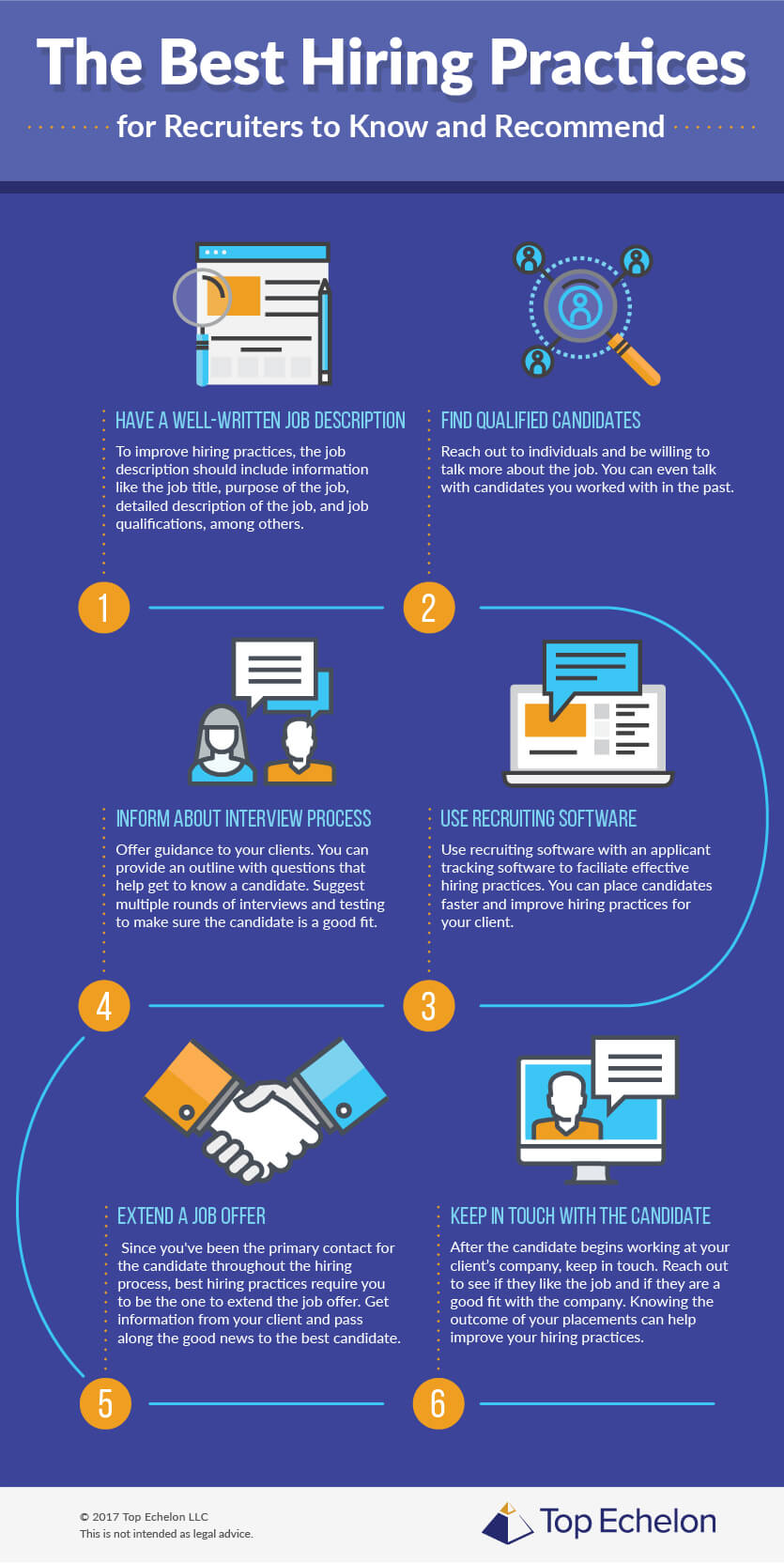As a recruiter, you are an important part of a business’s hiring practices. You have the responsibility of finding strong candidates for your clients. You might also need to give clients tips on best hiring practices for the steps you are not part of, like interviewing.
To make sure your recruiting process is successful, you need to know hiring practices. Having a solid grasp on hiring practices and conveying that information to your clients will have a strong impact in your recruitment process.
How to facilitate effective hiring practices for your clients
When a business hires a recruiter, they gain a valuable asset to their hiring process. You find candidates and sort through job applications to help find the best candidates for your clients.
Take a look at some ways both you and your clients can improve hiring practices.
1. Have a well-written job description in place
Implementing effective sourcing strategies starts with a job description. When you receive a job order from your client, they should also provide a job description. However, sometimes the job description is vague and does not list job qualifications or day-to-day activities.
As a result, you might need to rewrite the job description. In order to improve hiring practices, the job description must be well-written. It should clearly state information like the job title, purpose of the job, detailed description of the job, and job qualifications, among others. If not, you won’t be able to attract qualified applicants to fill the job order.
Talk with your client about what a good job description needs. If the job description needs to be rewritten, ask your client for more details about the job. Then, offer to rewrite the job description. You could even proactively write a few different versions of the job description, and see if your client prefers any of them to the existing description.
2. Find qualified candidates
When it comes to hiring, you are tasked with finding qualified candidates for your client. That means using online job posting boards, reaching out to potential candidates, and looking through your pool of candidates you have worked with in the past.
Finding top-tier candidates for your client goes beyond posting a job description on a job posting site. You also need to reach out to individuals and be willing to talk more about the job. In order to find qualified candidates, you need to talk with candidates you have worked with in the past to see if they should apply for the job.
3. Use recruiting software to sort through applicants
A business might hire a recruiter for a variety of reasons: they can’t find qualified candidates, they don’t have time to sort through applications, they want to make sure the hiring and placement process is done right, or they need a new employee immediately.
Your client needs a job order filled quickly. They want you to be able to find the best possible candidates in a short amount of time. When the applications come pouring in, you need to be able to sort through qualified and under-qualified applicants. Use recruiting software with an applicant tracking system to help facilitate effective hiring practices.
With recruiting software, applicants are automatically sorted so you know who is most qualified for the job order. You can place candidates faster, improving hiring practices for your client.
4. Talk to your client about the interview process
Even if your client is in a rush to fill an open job, following best hiring practices means taking their time. If a business rushes into new hires without evaluating the candidates first, they could end up with a high employee turnover rate.
Some businesses do not probe the interviewee enough during the interview process. In order to improve hiring practices, businesses need to take their time during the interview and ask situational questions directly related to the job responsibilities.
As a recruiter, you can offer guidance to your clients. You can even provide an outline for them that details the types of questions that really get to know a candidate. Make sure that your client conducts multiple rounds of interviews. Suggest testing to further make sure the candidate is a good fit.
5. Extend a job offer
Since you’ve been the primary contact for the candidate throughout the hiring process, best hiring practices require you to be the one to extend the job offer. Your client provides you with information about compensation. Then, you pass along the good news to the best candidate.
It’s common for a candidate to turn down a job offer. By encouraging your client to let you extend the job offer, you might have more success with getting the candidate to accept. You’ve been the person working with the candidate, so they might feel more comfortable talking to you about other offers, negotiations, or any qualms they have about the job.
6. Keep in touch with the candidate
After the candidate begins working at your client’s company, keep in touch. Reach out to them to see if they like the job and if they are a good fit with the company. Knowing the outcome of your placements can help improve your hiring practices for future job orders.










